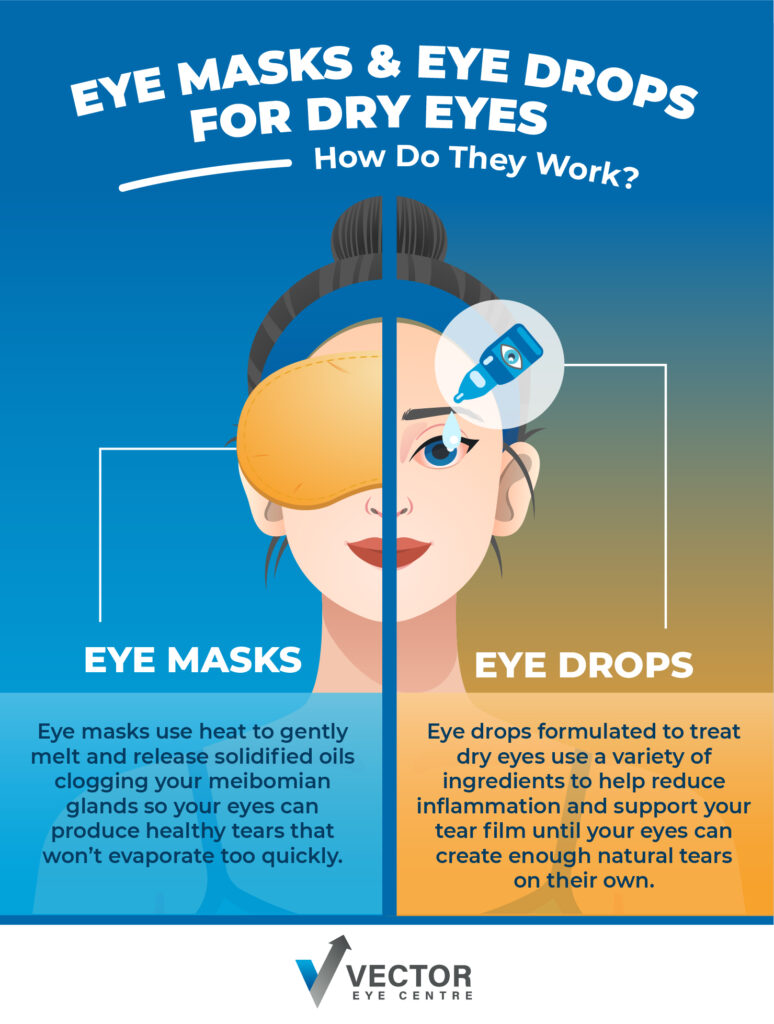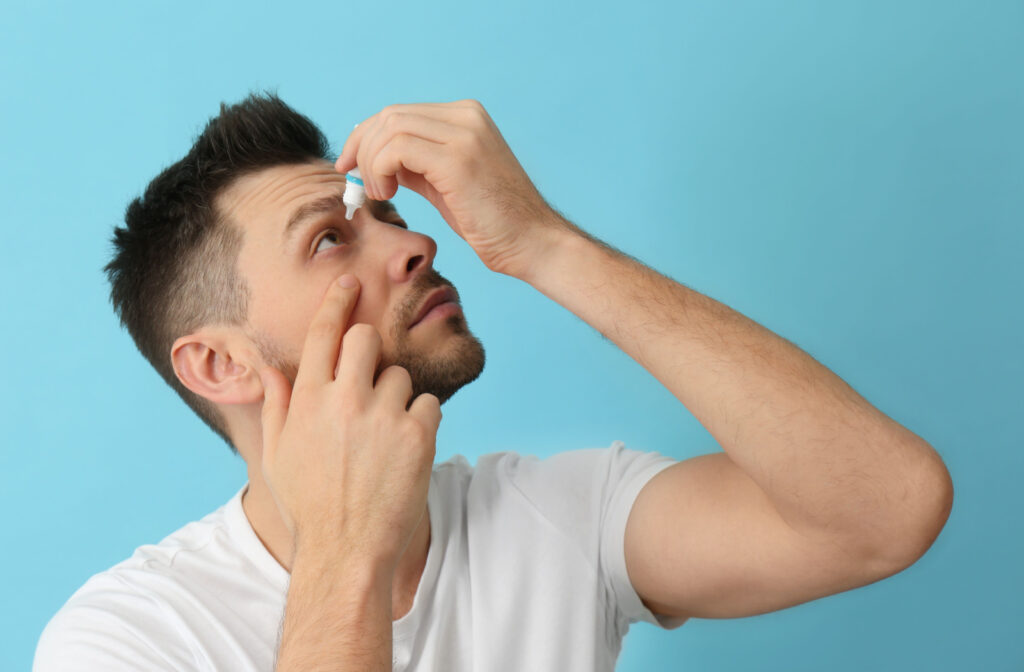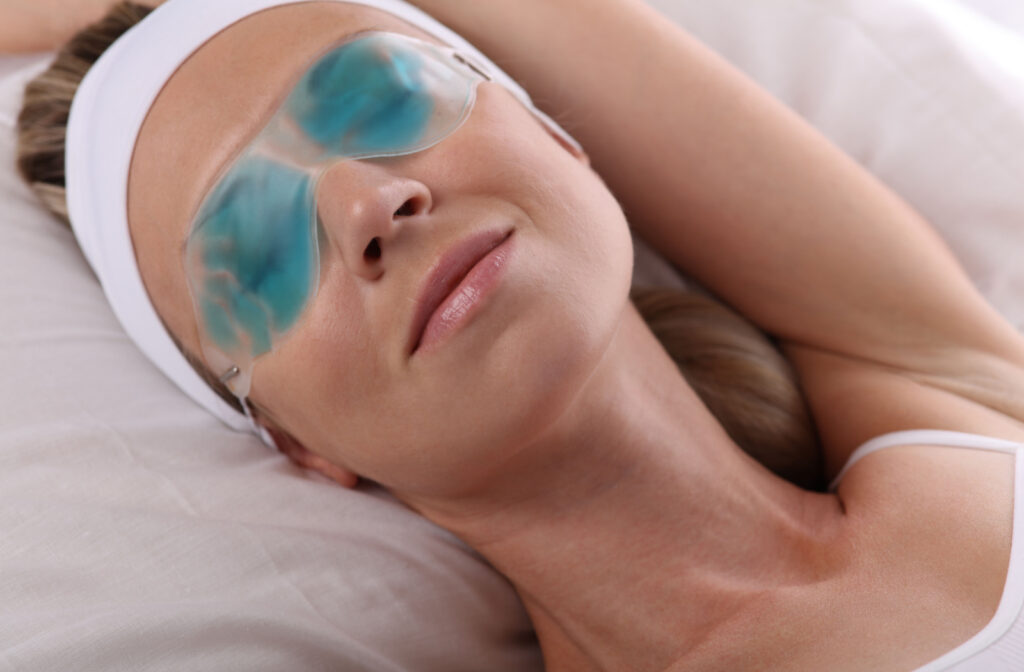With the myriad options available for modern dry eye treatment, it’s important to know how different at-home treatments work to relieve specific causes of dry eye syndrome. Picking the treatment that matches your needs is crucial for getting lasting relief.
Eye masks can treat dry eyes by gently warming your eyes to promote healthy oil production for your tear film, while eye drops generally work by helping reduce dry eye symptoms caused by inflammation.
Dry eye disease is a complex condition with many causes and many forms of treatment—including advanced, in-office treatments like intense pulsed light therapy and radiofrequency treatments.
Making the right choice for your eyes often starts with understanding what’s causing your symptoms and working with an eye doctor to find a combination of at-home and in-office treatments that address the underlying cause of dry eyes.
How Do Eye Masks Relieve Dry Eye Symptoms?
There are several different types of eye masks you can use at home, but in general, they work by using heat to address a common cause of dry eyes: meibomian gland dysfunction (MGD).
Treating Meibomian Gland Dysfunction
MGD is a common cause of evaporative dry eye, a type of dry eye disease you can develop when your eyes aren’t producing enough oil to support your tear film—the layer of mucous, water, and lipids (oils) that protects your eyes and keeps them hydrated.
When your meibomian glands—the glands that produce oil—become clogged, your tear film may become unstable and evaporate too quickly, leaving your eyes dry. Eye masks use heat to gently melt and release solidified oils clogging your meibomian glands, helping support your tear film and reducing your dry eye symptoms.

How Do Eye Drops Treat Dry Eyes?
As with heat masks, there are several different types of eye drops available for dry eye relief, such as artificial tears, prescription eye drops, and even eye drops created with a serum derived from your blood. They all work slightly differently, but in general, many of them are created to help address dry eye symptoms caused by inflammation.
It’s important to speak with your eye doctor before taking eye drops for dry eyes, as not all eye drops are the same. Using eye drops formulated to treat your specific needs is crucial for getting lasting relief and maintaining your eye health.
Treating Inflammation
When inflammation occurs on the surface of your eyes or the skin around your eyes, it can disrupt your natural tear production and reduce the amount of tears your eyes make, leaving you with aqueous deficient dry eye—dry eye caused by a lack of tears.
Eye drops formulated to treat dry eyes use a variety of ingredients, including immunomodulators, steroids, and specialized serums, to help reduce inflammation so your eyes can create enough natural tears. In some cases, eye drops can also be used to supplement your natural tears until your eyes can produce enough on their own.
What Are the Other Treatments for Dry Eye Disease?
Eye drops and eye masks alone may not be enough to provide lasting relief for your dry eye symptoms. In cases where you’re affected by chronic redness, discomfort, watery eyes, and other issues, there are also in-office treatments you can combine with eye masks and eye drops to amplify your ability to get relief.
Intense pulsed light (IPL) therapy is a form of dry eye treatment that uses pulses of gentle light to heat your meibomian glands. IPL can also improve tear flow and reduce inflammation. The IPL process typically involves just 3 short sessions at Vector Eye Centre. A minority of patients schedule routine visits every 6–12 months to maintain their results. However, for the majority, 3 treatments are sufficient with continued heat, massage, hygiene, blinking and artificial tears over the long term.
Radiofrequency (RF) treatments also use heat to treat dry eyes by unclogging oil glands. The heat in RF treatments comes from electromagnetic waves and can also reduce inflammation. As with IPL, RF treatments typically require 3 treatments for lasting results in combination with heat, massage, hygiene, blinking and artificial tears.
LipiFlow is another dry eye treatment that involves applying noninvasive heat adapters to the upper and lower eyelids. With gentle heat and pressure, LipiFlow treatments can warm and massage clogged meibomian glands to express trapped oils.
The treatments above can be used in combination with at-home solutions like eye masks and eye drops to help you address underlying causes of dry eye disease and get relief from sudden symptom flare-ups at home.
Treatments like IPL, RF, and LipiFlow aren’t your only options for treating dry eyes. In some cases, there may be surgical treatments, habitual and environmental changes, and dietary changes you can choose to address dry eye symptoms.

Which Symptoms of Dry Eyes Can You Treat?
Treatments that address the underlying cause of dry eyes can provide relief from several uncomfortable dry eye symptoms, including:
- Gritty, burning sensations
- Redness
- Watery eyes
- The feeling that something is in your eye
- Pain when wearing contact lenses
- Difficulty driving at night
- Blurry vision
You may be able to get temporary symptom relief using eye masks and eye drops, but in-office treatments can offer a path toward lasting, long-term relief by addressing issues like meibomian gland dysfunction and inflammation.
Treatments & Advice for Dry Eyes
We know how frustrating and uncomfortable dry eyes can be. That’s why we strive to offer so many modern options for dry eye treatment. We love helping patients get relief with the right combination of at-home strategies and in-office treatments for their unique eyes.
Contact us at Vector Eye Centre to learn more about your options for dry eye treatment and to get advice for managing your symptoms at home.



